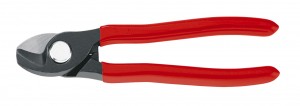Cable cutters are the basic tools for every technician and electrician. Cutting cables can be quick and trouble-free ,if you use an effective tool.
Traditional cable cutters

An example of the traditional cable cutters for cutting and stripping of aluminum and copper wires are RC 15. However the outer diameter of the cable cannot exceed 15 mm, and the cross-section can be up to 50 mm2. They are not designed for cutting armoured and reinforced cables. They cannot be used for cutting the copper wire drawn cold. Durable blades cut without cable crushing and deformation.
RC 15 S is another tool very similar to the previously mentioned RC15. It has some distinguishing features: it has special blades profile enables one-handed cutting. The handles seems to be better suited in case of this tool.
RC 20 is able to cut wires with the cross-section up to 70 mm2, it is possible thanks to twin blades. Initial cut is done in outer cutting area, the final cut is done in inner cutting area, close to the axis of rotation.
Cable cutters RC 27 differ from the other cable cutters not only in construction. They have been made in such a way that it is possible to cut wires with the cross-section up to 150 mm2. The handles are made of special aluminum tube, and low hand-force is required due to geometrically optimized blades. Wires with the cross-section up to 300 mm2 can be cut with RCO 32 cable cutters.
Cable cutters – cutting under voltage
For cutting under voltage the traditional cable cutters are not enough. The handle must be designed in such a way that the work is perfectly safe. An example of such a tool are cable cutters RC 5, that can cut wires with the outer diameter up to 5 mm or a steel cable with the diameter to 2 mm. Both the shaped blade and lever are designed to optimize the force required for cutting. RC 13 cable cutters will cut cables with the cross-section up to 60 mm2. The blades made of special steel are there to make this cutting easier.
 |
Cable cutter in E-catalog. |


